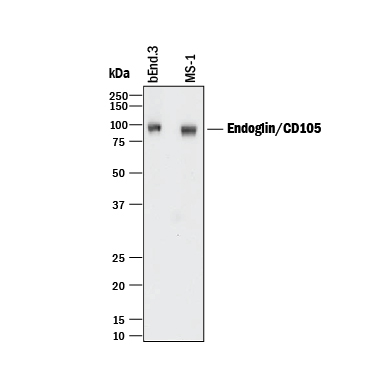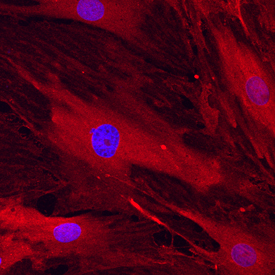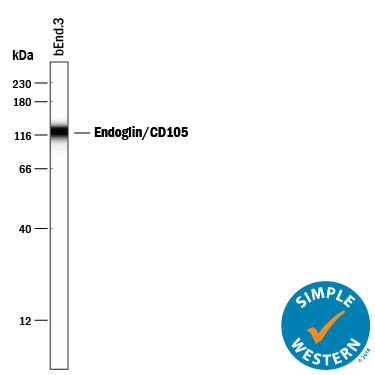Mouse Endoglin/CD105 Antibody Summary
Glu27-Gly581
Accession # Q8K100
Applications
Please Note: Optimal dilutions should be determined by each laboratory for each application. General Protocols are available in the Technical Information section on our website.
Scientific Data
 View Larger
View Larger
Detection of Mouse Endoglin/CD105 by Western Blot. Western blot shows lysates of bEnd.3 mouse endothelioma cell line and MS-1 mouse pancreatic islet endothelial cell line. PVDF membrane was probed with 0.5 µg/mL of Goat Anti-Mouse Endoglin/CD105 Antigen Affinity-purified Polyclonal Antibody (Catalog # AF1320) followed by HRP-conjugated Anti-Goat IgG Secondary Antibody (Catalog # HAF017). A specific band was detected for Endoglin/CD105 at approximately 90-95 kDa (as indicated). This experiment was conducted under reducing conditions and using Immunoblot Buffer Group 1.
 View Larger
View Larger
Endoglin/CD105 in MS-1 Mouse Cell Line. Endoglin/CD105 was detected in immersion fixed MS-1 mouse pancreatic islet endothelial cell line using Goat Anti-Mouse Endoglin/CD105 Antigen Affinity-purified Polyclonal Antibody (Catalog # AF1320) at 10 µg/mL for 3 hours at room temperature. Cells were stained using the NorthernLights™ 557-conjugated Anti-Goat IgG Secondary Antibody (yellow; Catalog # NL001) and counter-stained with DAPI (blue). View our protocol for Fluorescent ICC Staining of Cells on Coverslips.
 View Larger
View Larger
Endoglin/CD105 in Rat Mesenchymal Stem Cells. Endoglin/CD105 was detected in immersion fixed rat mesenchymal stem cells using Goat Anti-Mouse Endoglin/CD105 Antigen Affinity-purified Polyclonal Antibody (Catalog # AF1320) at 10 µg/mL for 3 hours at room temperature. Cells were stained using the NorthernLights™ 557-conjugated Anti-Goat IgG Secondary Antibody (red; Catalog # NL001) and counterstained with DAPI (blue). Specific staining was localized to cytoplasm. View our protocol for Fluorescent ICC Staining of Cells on Coverslips.
 View Larger
View Larger
Endoglin/CD105 in Mouse Embryo. Endoglin/CD105 was detected in immersion fixed frozen sections of mouse embryo (E13-15) using Goat Anti-Mouse Endoglin/CD105 Antigen Affinity-purified Polyclonal Antibody (Catalog # AF1320) at 15 µg/mL overnight at 4 °C. Tissue was stained using the Anti-Goat HRP-DAB Cell & Tissue Staining Kit (brown; Catalog # CTS008) and counterstained with hematoxylin (blue). Lower panel shows a lack of labeling if primary antibodies are omitted and tissue is stained only with secondary antibody followed by incubation with detection reagents. View our protocol for Chromogenic IHC Staining of Frozen Tissue Sections.
 View Larger
View Larger
Detection of Mouse Endoglin/CD105 by Simple WesternTM. Simple Western lane view shows lysates of bEnd.3 mouse endothelioma cell line, loaded at 0.2 mg/mL. A specific band was detected for Endoglin/CD105 at approximately 121 kDa (as indicated) using 5 µg/mL of Goat Anti-Mouse Endoglin/CD105 Antigen Affinity-purified Polyclonal Antibody (Catalog # AF1320) followed by 1:50 dilution of HRP-conjugated Anti-Goat IgG Secondary Antibody (Catalog # HAF109). This experiment was conducted under reducing conditions and using the 12-230 kDa separation system.
Reconstitution Calculator
Preparation and Storage
- 12 months from date of receipt, -20 to -70 °C as supplied.
- 1 month, 2 to 8 °C under sterile conditions after reconstitution.
- 6 months, -20 to -70 °C under sterile conditions after reconstitution.
Background: Endoglin/CD105
Endoglin (CD105) is a 90 kDa type I transmembrane glycoprotein of the zona pellucida (ZP) family of proteins (1-3). Endoglin and betaglycan/T beta RIII are type III receptors for TGF beta superfamily ligands, sharing 71% amino acid (aa) identity within the transmembrane (TM) and cytoplasmic domains. Endoglin is highly expressed on proliferating vascular endothelial cells, chondrocytes, and syncytiotrophoblasts of term placenta, with lower amounts on hematopoietic, mesenchymal and neural crest stem cells, activated monocytes, and lymphoid and myeloid leukemic cells (2-5). Mouse Endoglin cDNA encodes 653 aa including a 26 aa signal sequence, a 555 aa extracellular domain (ECD) with an orphan domain and a two-part ZP domain, a TM domain, and a 47 aa cytoplasmic domain (1-3). A mouse isoform with a 35 aa cytoplasmic domain (S-endoglin) can oppose effects of long (L) Endoglin (6, 7). The mouse Endoglin ECD shares 69%, 84%, 62%, 63%, and 66% aa identity with human, rat, bovine, porcine, and canine Endoglin, respectively. Endoglin homodimers interact with TGF-beta 1 and TGF-beta 3 (but not TGF-beta 2) but only after binding T beta RII (8). Similarly, they interact with activin-A and BMP-7 via activin type IIA or B receptors, and with BMP-2 via BMPR-1A/ALK-3 or BMPR-1B/ALK-6 (9). BMP-9, however, is reported to bind Endoglin directly (10). Endoglin modifies ligand-induced signaling in multiple ways. For example, expression of Endoglin can inhibit TGF-beta 1 signals but enhance BMP7 signals in the same myoblast cell line (11). In endothelial cells, Endoglin inhibits T beta RI/ALK5, but enhances ALK1-mediated activation (12). Deletion of mouse Endoglin causes lethal vascular and cardiovascular defects, and human Endoglin haploinsufficiency can a cause the vascular disorder, hereditary hemorrhagic telangiectasia type I (13, 14). These abnormalities confirm the essential function of Endoglin in differentiation of smooth muscle, angiogenesis, and neovascularization (2-4, 12-14). In preeclampsia of pregnancy, high levels of proteolytically generated soluble Endoglin and VEGF R1 (sFlt-1), along with low placental growth factor (PlGF), are pathogenic due to antiangiogenic activity (15).
- Ge, A.Z. and E.C. Butcher (1994) Gene 138:201.
- ten Dijke, P. et al. (2008) Angiogenesis 11:79.
- Bernabeu, C. et al. (2007) J. Cell. Biochem. 102:1375.
- Mancini, M.L. et al. (2007) Dev. Biol. 308:520.
- Moody, J.L. et al. (2007) Stem Cells 25:2809.
- Velasco, S. et al. (2008) J. Cell Sci. 121:913.
- Perez-Gomez, E. et al. (2005) Oncogene 24:4450.
- Cheifetz, S, et al. (1992) J. Biol. Chem. 267:19027.
- Barbara, N.P. et al. (1999) J. Biol. Chem. 274:584.
- Scharpfenecker, M. et al. (2007) J. Cell Sci. 120:964.
- Scherner, O. et al. (2007) J. Biol. Chem. 282:13934.
- Pece-Barbara, N. et al. (2005) J. Biol. Chem. 280:27800.
- Arthur, H.M. et al. (2000) Dev. Biol. 217:42.
- Lebrin, F. and C.L. Mummery (2008) Trends Cardiovasc. Med. 18:25.
- Venkatesha, S. et al. (2006) Nat. Med. 12:642.
Product Datasheets
Citations for Mouse Endoglin/CD105 Antibody
R&D Systems personnel manually curate a database that contains references using R&D Systems products. The data collected includes not only links to publications in PubMed, but also provides information about sample types, species, and experimental conditions.
18
Citations: Showing 1 - 10
Filter your results:
Filter by:
-
Mitochondrial respiration supports autophagy to provide stress resistance during quiescence
Authors: S Magalhaes-, J Blecha, R Naraine, J Mikesova, P Abaffy, A Pecinova, M Milosevic, R Bohuslavov, J Prochazka, S Khan, E Novotna, R Sindelka, R Machan, M Dewerchin, E Vlcak, J Kalucka, S Stemberkov, A Benda, J Goveia, T Mracek, C Barinka, P Carmeliet, J Neuzil, K Rohlenova, J Rohlena
Autophagy, 2022-03-08;0(0):1-18.
Species: Human
Sample Types: Cell Lysates
Applications: Western Blot -
Bevacizumab dose adjustment to improve clinical outcomes of glioblastoma
Authors: N García-Rom, I Palacín-Al, R Madurga, J Carrión-Na, S Esteban-Ru, B Jiménez, A Collazo, F Pérez-Rodr, A Ortiz de M, C Fernández-, S García-Duq, J Diamantopo, C Belda-Inie, R Prat-Acín, P Sánchez-Gó, E Calvo, A Ayuso-Saci
BMC Med, 2020-06-22;18(1):142.
Species: Mouse
Sample Types: Whole Tissue
Applications: IHC -
PS1 FAD mutants decrease ephrinB2-regulated angiogenic functions, ischemia-induced brain neovascularization and neuronal survival
Authors: Y Yoon, G Voloudakis, N Doran, E Zhang, C Dimovasili, L Chen, Z Shao, S Darmanis, C Tang, J Tang, VX Wang, PR Hof, NK Robakis, A Georgakopo
Mol. Psychiatry, 2020-06-15;0(0):.
Species: Mouse
Sample Types: Whole Cells
Applications: ICC -
C-KIT Expression Distinguishes Fetal from Postnatal Skeletal Progenitors
Authors: DD He, XT Tang, W Dong, G Cui, G Peng, X Yin, Y Chen, N Jing, BO Zhou
Stem Cell Reports, 2020-03-26;0(0):.
Species: Mouse
Sample Types: Whole Tissue
Applications: IHC -
Correlation of two distinct metastasis-associated proteins, MTA1 and S100A4, in angiogenesis for promoting tumor growth
Authors: M Ishikawa, M Osaki, M Yamagishi, K Onuma, H Ito, F Okada, H Endo
Oncogene, 2019-02-11;0(0):.
Species: Xenograft
Sample Types: Whole Tissue
Applications: IHC-P -
Role of glutamine synthetase in angiogenesis beyond glutamine synthesis
Authors: G Eelen, C Dubois, AR Cantelmo, J Goveia, U Brüning, M DeRan, G Jarugumill, J van Rijsse, G Saladino, F Comitani, A Zecchin, S Rocha, R Chen, H Huang, S Vandekeere, J Kalucka, C Lange, F Morales-Ro, B Cruys, L Treps, L Ramer, S Vinckier, K Brepoels, S Wyns, J Souffreau, L Schoonjans, WH Lamers, Y Wu, J Haustraete, J Hofkens, S Liekens, R Cubbon, B Ghesquière, M Dewerchin, FL Gervasio, X Li, JD van Buul, X Wu, P Carmeliet
Nature, 2018-08-29;561(7721):63-69.
Species: Mouse
Sample Types: Whole Tissue
Applications: IHC, IHC-Fr -
Blockade of myeloid-derived suppressor cell expansion with all-trans retinoic acid increases the efficacy of anti-angiogenic therapy
Authors: R Bauer, F Udonta, M Wroblewski, I Ben-Batall, IM Santos, F Taverna, M Kuhlencord, V Gensch, S Päsler, S Vinckier, JM Brandner, K Pantel, C Bokemeyer, T Vogl, J Roth, P Carmeliet, S Loges
Cancer Res., 2018-04-19;0(0):.
Species: Mouse
Sample Types: Whole Tissue
Applications: IHC-P -
Multicolor quantitative confocal imaging cytometry
Authors: DL Coutu, KD Kokkaliari, L Kunz, T Schroeder
Nat. Methods, 2017-11-13;15(1):39-46.
Species: Mouse
Sample Types: Whole Tissue
Applications: IHC -
Mast cells decrease efficacy of anti-angiogenic therapy by secreting matrix-degrading granzyme B
Authors: M Wroblewski, R Bauer, M Cubas Córd, F Udonta, I Ben-Batall, K Legler, C Hauser, J Egberts, M Janning, J Velthaus, C Schulze, K Pantel, C Bokemeyer, S Loges
Nat Commun, 2017-08-16;8(1):269.
Species: Mouse
Sample Types: Whole Tissue
Applications: IHC -
Pharmacologic or Genetic Targeting of Glutamine Synthetase Skews Macrophages toward an M1-like Phenotype and Inhibits Tumor Metastasis
Authors: EM Palmieri, A Menga, R Martín-Pér, A Quinto, C Riera-Domi, G De Tullio, DC Hooper, WH Lamers, B Ghesquière, DW McVicar, A Guarini, M Mazzone, A Castegna
Cell Rep, 2017-08-15;20(7):1654-1666.
Species: Mouse
Sample Types: Whole Tissue
Applications: IHC -
DNA sequences within glioma-derived extracellular vesicles can cross the intact blood-brain barrier and be detected in peripheral blood of patients
Authors: N García-Rom, J Carrión-Na, S Esteban-Ru, E Lázaro-Ibá, M Peris-Celd, MM Alonso, J Guzmán-De-, C Fernández-, AO de Mendivi, S García-Duq, C Escobedo-L, R Prat-Acín, C Belda-Inie, A Ayuso-Saci
Oncotarget, 2017-01-03;8(1):1416-1428.
Species: Mouse
Sample Types: Whole Tissue
Applications: IHC -
PI3 kinase inhibition improves vascular malformations in mouse models of hereditary haemorrhagic telangiectasia
Nat Commun, 2016-11-29;7(0):13650.
Species: Mouse
Sample Types: Whole Tissue
Applications: IHC -
Gene Electrotransfer of Plasmid with Tissue Specific Promoter Encoding shRNA against Endoglin Exerts Antitumor Efficacy against Murine TS/A Tumors by Vascular Targeted Effects.
Authors: Stimac M, Dolinsek T, Lampreht U, Cemazar M, Sersa G
PLoS ONE, 2015-04-24;10(4):e0124913.
Species: Mouse
Sample Types: Whole Tissue
Applications: IHC-P -
LF-15 & T7, synthetic peptides derived from tumstatin, attenuate aspects of airway remodelling in a murine model of chronic OVA-induced allergic airway disease.
Authors: Grafton K, Moir L, Black J, Hansbro N, Hansbro P, Burgess J, Oliver B
PLoS ONE, 2014-01-15;9(1):e85655.
Species: Human
Sample Types: Whole Tissue
Applications: IHC -
In vivo adeno-associated viral vector-mediated genetic engineering of white and brown adipose tissue in adult mice.
Authors: Jimenez V, Munoz S, Casana E, Mallol C, Elias I, Jambrina C, Ribera A, Ferre T, Franckhauser S, Bosch F
Diabetes, 2013-09-16;62(12):4012-22.
Species: Mouse
Sample Types: Whole Tissue
Applications: IHC -
Multiple delivery of siRNA against endoglin into murine mammary adenocarcinoma prevents angiogenesis and delays tumor growth.
Authors: Dolinsek T, Markelc B, Sersa G, Coer A, Stimac M, Lavrencak J, Brozic A, Kranjc S, Cemazar M
PLoS ONE, 2013-03-05;8(3):e58723.
Species: Mouse
Sample Types: Whole Cells
Applications: IHC -
Focal adhesion kinase regulates the localization and retention of pro-B cells in bone marrow microenvironments.
Authors: Park S, Wolfram P, Canty K, Harley B, Nombela-Arrieta C, Pivarnik G, Manis J, Beggs H, Silberstein L
J Immunol, 2012-12-21;190(3):1094-102.
Species: Mouse
Sample Types: Whole Tissue
Applications: IHC -
Direct transcriptional regulation of neuropilin-2 by COUP-TFII modulates multiple steps in murine lymphatic vessel development.
Authors: Lin FJ, Chen X, Qin J, Hong YK, Tsai MJ, Tsai SY
J. Clin. Invest., 2010-04-01;120(5):1694-707.
Species: Mouse
Sample Types: Whole Tissue
Applications: IHC-P
FAQs
No product specific FAQs exist for this product, however you may
View all Antibody FAQsReviews for Mouse Endoglin/CD105 Antibody
Average Rating: 5 (Based on 1 Review)
Have you used Mouse Endoglin/CD105 Antibody?
Submit a review and receive an Amazon gift card.
$25/€18/£15/$25CAN/¥75 Yuan/¥2500 Yen for a review with an image
$10/€7/£6/$10 CAD/¥70 Yuan/¥1110 Yen for a review without an image
Filter by:





